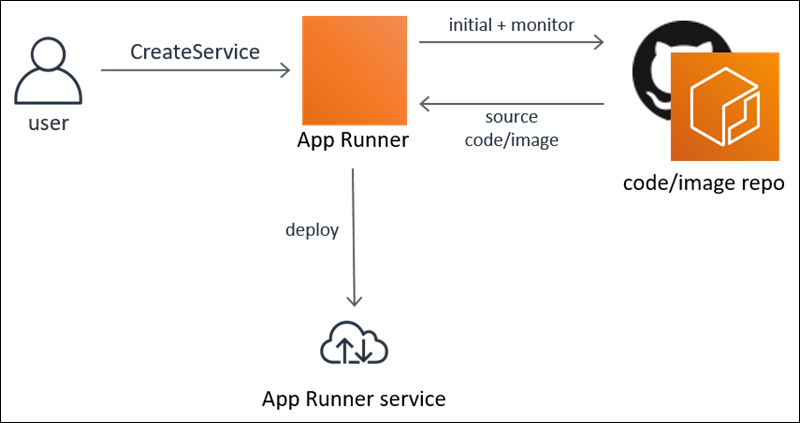
AppRunner - The Good, Bad and the Ugly
Background
In May of 2021, AWS released AppRunner to the public.
AWS App Runner is an AWS service that provides a fast, simple, and cost-effective way to deploy from source code or a container image directly to a scalable and secure web application in the AWS Cloud. You don’t need to learn new technologies, decide which compute service to use, or know how to provision and configure AWS resources.
App Runner connects directly to your code or image repository. It provides an automatic integration and delivery pipeline with fully managed operations, high performance, scalability, and security.

What makes AppRunner so compelling are these important features:
- Creates the entire infrastructure required for hosting a scalable web application
- Connects directly to your code or image repository AND can automatically redeploy the application when assets are updated
- Can scale up or down based on traffic
- Very cost effective - you only pay for resources consumed when your application is in use
- Associate your custom domain with an AppRunner endpoint.
- It’s much less expensive than provisioning all of the resources necessary to host your application yourself!
My Use Case
Back in 2012, I started a SaaS application (Treasurer’s Briefcase) for providing recordkeeping services for small non-profit organizations like PTOs, PTAs and Booster clubs. Back then, I cobbled together the infrastructure using the console, then started to explore CloudFormation and eventually re-architected everything using Terraform.
The application is essentially based on a LAMP stack - well sort of since I use a different templating web framework rather than PHP. The stack consists of an EC2 that hosts the Apache server, an EC2 that hosts some backend services, an ALB, a MySQL RDS instance and a VPC. There are a few other AWS services used like S3, SQS and EFS, but essentially the stack is relatively simple. Even so, provisioning all of that infrastructure using Terraform alone and creating a development, test, and production environments was a bit daunting but a great learning experience.
Starting with the original infrastructure, I reverse engineered it
using terraforming and then
expanded it using terraform.
The point being, it wasn’t necessarily easy to get it all right the first time. Keeping up with Terraform was also a challenge as it evolved over the years too. Moreover, maintaining infrastructure was just another task that provided no incremental value to the application. Time spent on that task took away from creating new features and enhancements that could provide more value to customers.
Enter AppRunner…with the promise of taking all of that work and chucking it out the window. Imagine creating a Docker container with your application and handing it to AWS and saying “host this for me, make it scalable, create and maintain an SSL certificate for me, create a CI/CD pipeline to redeploy the application when I make changes and make it cheap.” I’m in.
Not So Fast Skippy
AppRunner has evolved over the years and has become much more mature. However, it still has some warts and pimples that might make you think twice about using it. Back in 2021 it was an interesting new service, an obvious evolutionary step from Fargate Tasks which provide some of the same features as AppRunner. Applications that utilized Fargate Tasks as the basis for running their containerized web applications still had to provision a VPC, load balancers, and manage scaling on their own. AppRunner bundles all of those capabilities and creates a compelling argument for moving Fargate based apps to AppRunner.
Prior to October 2022 AppRunner did not support the ability to access resources from within a VPC. That made it impossible for example, to use a non-publicly accessible RDS instance. With that addition in October of 2022, it was now possible to have a web application that could access your RDS in your VPC.
The fall of 2023 has seen several changes that make AppRunner even more compelling:
| Change | Description | Date |
|---|---|---|
| Release: App Runner adds supports for AWS Europe (Paris), AWS Europe (London), and AWS Asia Pacific (Mumbai) Regions | AWS App Runner now supports AWS Europe (Paris), AWS Europe (London), and AWS Asia Pacific (Mumbai) Regions. | November 8, 2023 |
| Release: App Runner adds dual stack support for incoming network traffic | AWS App Runner now adds dual stack support for incoming traffic through public endpoints. | November 2, 2023 |
| Release: App Runner automates Route 53 domain configuration for your services | AWS App Runner automates Route 53 domain configuration for your App Runner service web applications. | October 4, 2023 |
| Release: App Runner adds support for monorepo source-code based services | AWS App Runner now supports the deployment and maintenance for monorepo source-code based services. | September 26, 2023 |
| Release: App Runner adds more features to auto scaling configuration management | AWS App Runner enhances auto scaling configuration management features. | September 22, 2023 |
Some of the limitations of AppRunner currently include:
- Inability to mount file systems (like EFS)
- While you can associate a custom domain, it cannot provision www from the console (in fact I have been unable to get it to work properly from the CLI either although the documentation indicates it should work)
- Still unavailable in some regions
- Cannot use security groups to limit access
The first limitation is a bit of show-stopper for more than a few web applications that might rely on mounted file systems to access assets or provide a stateful storage environment. For my application I use EFS to create session directories for logged in users. Using EFS I can be assured that each EC2 in my web farm accesses the user’s session regardless of which EC2 serves the request. Without EFS, I will be forced to re-think how to create a stateful storage environment for my web app. I could use S3 as storage (and probably should) but EFS provided a “quick-shot-on-goal” at the time.
The second limitation was just frustrating as associating a custom domain sort of kinda works. If I associate a domain managed by AWS (in the same account as my AppRunner application) then I was able to get the TLD to resolve and work as expected. AppRunner was able to associate my appliation to the domain AND provide an SSL certificate. It will redirect any http request to https. Unfortunately, I could not associate www sub-domain using the CLI as documented. In fact I could not even get the CLI to work without trying to enable the www sub-domain. Working with AWS support confirmed my experience and I still have a ticket pending with support on this issue. I’m confident that will be resolved soon(?) so it should not limit my ability to use this service in the future.
Conclusion
AppRunner is an exciting new service that will make application development and deployment seamless allowing developers to focus on the application not the infrastructure.
You can find the AppRunner roadmap and current issues here.

 www.linkedin.com/in/robert-lauer-1590513
www.linkedin.com/in/robert-lauer-1590513